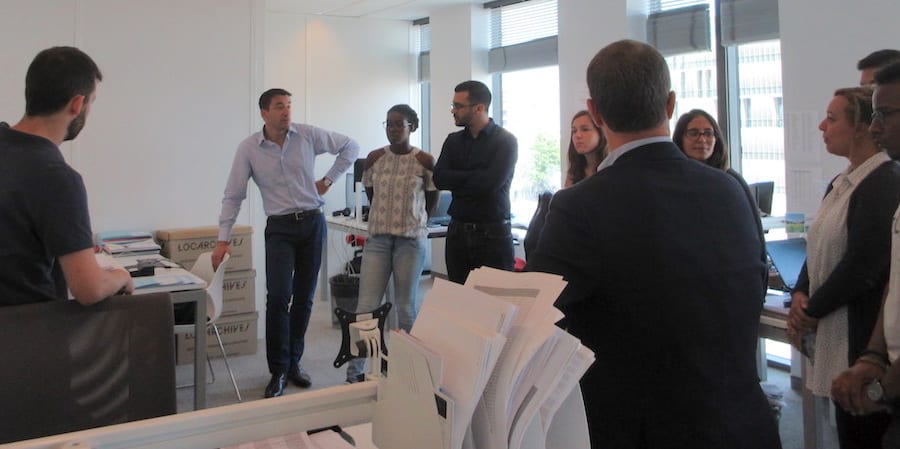
The impressive lean turnaround of DBS Bank in Singapore
CASE STUDY – Over the past few years, DBS Bank in Singapore has undergone an extraordinary lean transformation. Here, the COO explains how the company has become the world's "best digital bank".
Words: Paul Cobban, Chief Operating Officer, Technology and Operations, DBS Bank
At DBS Bank, we were recently trying to find ways to make it easier for children in Singapore to pay for their school meals. One idea we were pursuing was to provide them with wearable technology they could use in lieu of cash. Upon talking to several parents, however, we learned they were concerned their children might grow up not understanding the value of money that handling a note teaches you. As soon as we realized we were off the mark, we adjusted our approach to the wearable project.
It’s hard to fathom the amount of waste we avoided generating by simply talking to our customers. And the truth is that, regardless of how much waste you can remove from your processes, there will never be a bigger form of waste than offering customers a service or a product they don’t want or need.
Eliminating waste even before producing it, so to speak, is only possible in a business that is deeply committed to understanding customer needs by means of observation, data analysis and experimentation. This customer-focused approach has very much been at the heart of DBS Bank’s strategy for the past few years.
It all started in 2009, when I was brought in to kick-start some process improvement work in one area of the business. At the time, we were all still reeling from the global financial crisis, and DBS management decided to focus on the “Asian-ness” of the business as a way to distance ourselves from what was going on in the West. At that time, Asia was the only part of the world where the banking sector had not imploded. One of the tenets of that strategy was “Asian service”, even though back then we were pretty much bottom of the pack when it came to customer satisfaction.
Indeed, “Asian service” was a long way away, but our heart was in the right place. We set out to drive improvement in our customer service, which necessarily meant defining what Asian service looked like. We were given six months, which we spent working with customers, staff and experts. This resulted in 96 ideas of what Asian service might actually mean. In August 2010, the top 50 people in DBS Bank met for two days and distilled those 96 down into three concepts: respectful, easy to deal with, and dependable – also known as RED. Not only is red an auspicious color in Asian cultures, it also happened to be one of our corporate colors. But it’s also an adjective, which quickly became part of the vocabulary of the company. To my surprise (the many ‘programs’ I had seen over the years had perhaps made me a bit cynical), our people loved the concept, and fully embraced it.
We wanted more than a slogan on a T-shirt, and so we adopted an approach that encompassed both hardware (the actual process improvement work) and “heartware”, a training program that would help people understand what we wanted our service to customers to be like.
Over time, we broke a lot of the rules in the book. Take the RED improvement projects, for example: to create awareness and get people excited about it, we did as many as we could, knowing full well that we didn’t have the capacity to support each and every one of the initiatives. But we got people to participate, and by making mistakes and running experiments, they started what – in hindsight – is the most important element of our lean transformation (though we never used the word “lean”): culture change.
THE REAL INNOVATION? MAKING BANKING “DISAPPEAR”
This doesn’t mean that we didn’t achieve a lot in the process improvement realm. One of the first things we did was using customer hours as our metric, essentially a measure of wait time, to analyse our processes to see how many customer hours we could take out of the system. We ended up removing 250 million over two years!
With over 250 ongoing improvement projects, we continued our work to make DBS a customer-focused bank. There was a pivotal moment, when we decided to reduce the time it took us to replace a lost credit card from five days to one. We knew that being without a credit card is very hard for people, so we wanted to help them get back to normal as quickly as possible. This time, however, we phoned the customer rather than simply implement the solution we thought would work. We phoned a woman who had lost her card and asked her, “would you like to get your credit card back in a day?” She said, “that’d be great, but what about my debit card?! I lost my bag in a shopping mall, and everything in it!” All of a sudden, it was like a light bulb had gone on, and we realized we had completely missed the actual customer need. What an a-ha moment! After that call, we rethought the whole process, making changes to what came to be known as the “customer journey”, and learned how critical it was to dig deep into the problems our customers face.
I can’t stress how important this insight of understanding what customers truly need was for us, as we determined our future direction. Nobody wakes up in the morning and thinks, “today is a great day to do banking!”. I truly believe that the future of this industry is “invisible banking”. If I don’t need a credit card to use an Uber, why do I need one to pay for a meal at a restaurant, for example?
This concept of “invisible banking” is shaping our entire approach to digitalization, which is clearly paying off, considering that in 2016 we were named by Euromoney (think of them of the Oscars for banks) as the world’s best digital bank. We have a massive digital agenda, but we are digitalizing with the customer needs always clear in our mind. For example, we recently launched a digital bank in India that is mobile-only, to ensure people could benefit from its services even in remote areas across the country, where infrastructure is notoriously poor and travelling can be quite time-consuming. People no longer have to travel to a branch to open an account. The creation of this forward-looking bank was possible because we looked at the customer’s journey in a transformational way. At the end of the day that, to me, is real innovation – articulating and understanding customer problems and solving them in a way that hasn't been done before. Our hackathons and the lean startup tools we use are important to give people the confidence to innovate, but alone they can only go so far.
INSPIRING PEOPLE, CHANGING A CULTURE
We are fortunate to have a very inspirational CEO, who has been around for eight years and always very consistent with the strategy. He has also supported our improvement initiatives very visibly. One way in which top leadership showed how strongly they believe in lean thinking was by encouraging people to start as many “RED projects” as they wanted, even though – as I mentioned – they knew many of them would fail. By letting them try, they allowed people to share their ideas, attempt new things, and learn from the experiments they ran. Early in our transformation, we hired an ex-journalist, whose job was to write two stories a week about the change we were trying to bring about. We still take communication extremely seriously, and we have gotten to a point where we don’t have enough people to write all the stories we have. We have also found that sharing what improvements take place at DBS with the outside world helps us get traction internally and attracts talent.
As every lean practitioner will know, changing an organization’s culture is perhaps the hardest part of a transformation. Our problem, for instance, was that both in Asia and in the banking industry the HiPPO (Highest Paid Person’s Opinion) mentality is very common. Getting away from that type of thinking has been a big priority for us: it entails removing fear from the work place and gradually learning to think differently. We are currently trying to instill the idea in our people that we need experiments to prove our theories.
We draw a lot of inspiration from large tech companies like Google, Netflix, Linkedin, Facebook, and so on. Just like Netflix is often described as an experimentation machine that happens to stream movies, we’d like to become an experimentation machine that happens to provide banking services. We want to be a bank that learns continuously, one experiment at a time.
Another important facet of the cultural change we are experiencing is actually real estate. I had no idea how powerful a vehicle physical space could be in driving cultural change, but it is when people move that new habits can be formed. You certainly can’t just throw a couple of bean bags in a corner and expect your people to become creative, and having been able to design our work space around the problem we are trying to solve has proved to be a successful approach for us. Even though we are all on the same floor, the layout of our work space was preventing teams from collaborating. So we decided to change everything: every person now takes a different seat every day, and even I have abandoned my office and now sit with everybody else. This is the best thing I have ever done! My meetings and emails have gone down by 80%, I know what’s going on all the time, and people approach me with issues they would not have chosen to raise before. It has really changed my working life, and that of the entire department.
This is the sort of behavioral change we want to achieve at DBS, and it all started with the right approach to leadership and customer needs.
THE AUTHOR

Read more


FEATURE – In this new series, the author taps into LEI Hungary’s experience with lean transformations to highlight the most common mistakes people make when approaching the A3 framework.


NOTES FROM THE GEMBA – Catherine’s gemba walks are back after the summer break. This month, she visits a start-up that is using lean to manage its growth, and learns about its management’s extraordinary turnaround.


ARTICLE – Standardization is often ignored and misunderstood, but is as critical to a lean transformation as continuous improvement. This piece by our Polish team explains why standard work is not to be neglected.


FEATURE – Our coverage of the Covid-19 emergency continues with an article discussing how lean healthcare principles can support and protect the professionals at the front line of this war.

